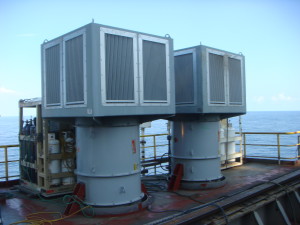Eldridge has been working with the offshore drilling industry since the 1950’s to provide innovative solutions for marine ventilation systems. When we were asked by a new marine customer to assist with ventilation system design for their ballast water treatment system on one of their barges, we were excited by the opportunity to put our vast marine ventilation system design experience to work.
Retrofit BWTS
The customer needed to retrofit an existing barge with a new ballast water treatment system (BWTS) within a tight schedule. For the BWTS enclosure consisting of upper and lower levels, they needed our help to design a ventilation system that had A/C for primary cooling and axial fans as back-up. The constraint for the back-up ventilation system was that the maximum temperature in the upper level could not exceed 104o F due to the type of chemical used in the BWTS. Additionally, regulations required that there be a minimum of 6 air changes for normal operation and 30 air changes in the event of a chemical leak.
For the upper level enclosure, we determined that the required amount of air flow needed, in the event of an A/C equipment failure, to keep the temperature below the maximum allowed for the chemical was greater than 6 air changes for normal operation. The lower level hazardous area back-up ventilation system was designed to provide 20 air changes and to have negative pressure to keep any hazardous fumes from exfiltrating the space.
Hazardous Environment Constraints
One of the constraints we were challenged with was the hazardous zone rating of the lower level. Not only did we need to incorporate the use of explosion proof fans, we needed to consider the location of the exhaust air flow so that it would not pose a threat to other areas of the vessel. To accomplish that, we strategically placed our patented Storm Guard Hood in locations where exhaust air flow could be directed away from any electrical apparatus that could spark an explosion. That in turn required a careful placement of the supply air hoods outside of the boundary of hazardous exhaust air flow so as to not draw it back into the BTWS enclosure.
Conclusion
At Eldridge, our passion is to help every customer be successful with their projects. That is why when we were challenged by the numerous constraints of this BWTS application, our marine ventilation system design was as much a work of art as it was a qualified scientific creation.
